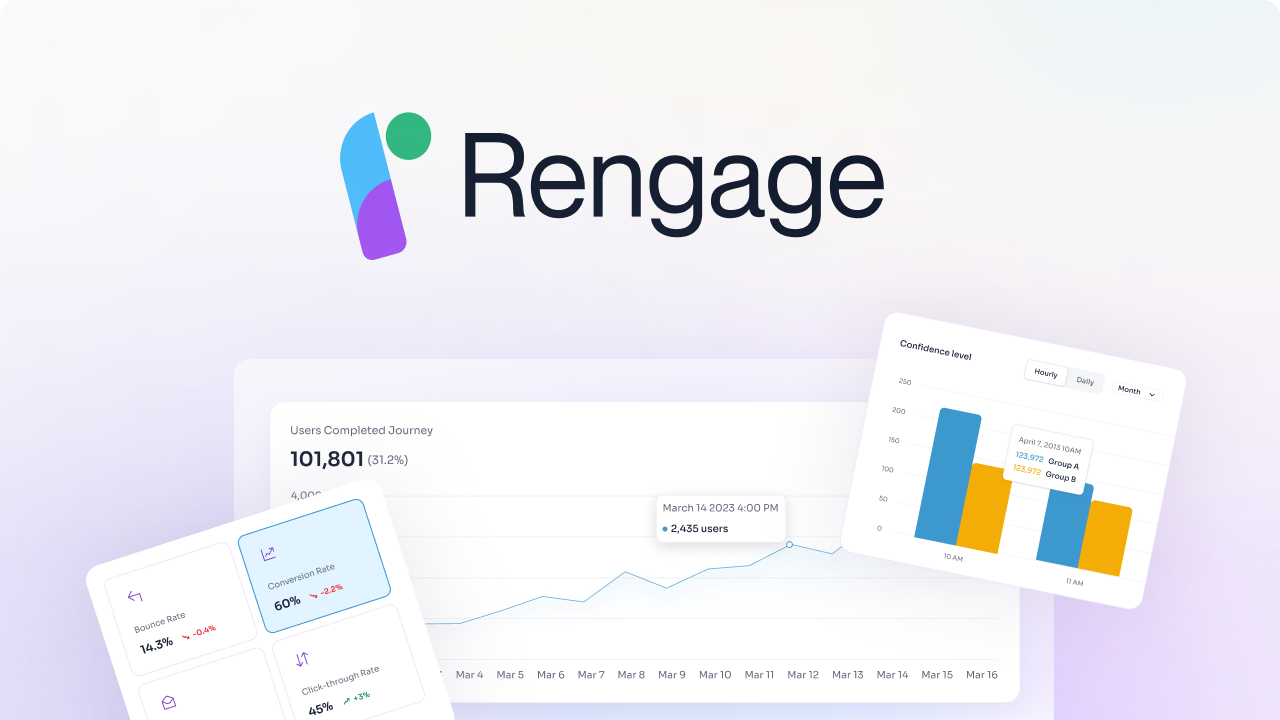Learn how businesses can leverage these techniques to enhance customer experiences and drive growth through customer lifecycle management and customer journey mapping.
What Is Digital Customer Journey Mapping?

Digital customer journey mapping is a crucial tool for businesses looking to understand and improve the way customers interact with their brand. Given the multitude of devices and touchpoints available today, it's critical to map out the entire digital customer journey.
This involves walking in your customer's shoes, leveraging data to predict customer behavior, and identifying gaps in the customer experience to deliver a seamless journey. The insights gained from digital customer journey mapping can inform content creation, address customer needs, and enhance overall business decisions.
What Are the 5 Stages of Digital Customer Journey?

1. Awareness – the Starting Point of the Journey
The digital customer journey starts with awareness. This is when a potential customer becomes aware of their need for a product or service, triggered by an online advertisement, social media post, or email campaign. At this stage, the customer is passive, merely observing and absorbing information.
They may learn about a new flavor of candy or a massage service they want to try based on online content. This phase is crucial for a business to create brand awareness, attract potential customers and entice them to learn more.
2. Consideration – Weighing Options and Deciding
Once aware of a product or service, the customer enters the consideration stage. In this phase, the customer actively thinks about their discovery and evaluates whether and where to make a purchase. Businesses invest heavily in digital marketing strategies during this stage to differentiate themselves, connect emotionally with customers, and provide added value.
It is vital to stand out from competitors and offer a unique selling proposition that resonates with the customer. Companies must emphasize the benefits of their brand and products to secure a place in the customer's mind and foster long-term loyalty.
3. Purchase – Sealing the Deal
After deliberating, the customer reaches the purchase stage. This is where the customer makes the decision to buy, making the buying experience crucial. If the online shopping process is cumbersome, with slow page loading times or complex payment procedures, customers are likely to abandon their carts.
To prevent this, businesses should focus on streamlining the purchase process, offering convenient features like autofill options, multiple payment methods, and competitive shipping choices. A seamless buying experience enhances customer satisfaction and reduces cart abandonment rates, boosting conversion rates and revenue.
4. Retention – Building Long-term Relationships
Post-purchase, the focus shifts to customer retention. Providing excellent customer service and support after the sale is essential for retaining customers and driving repeat business. Businesses can engage with customers through various digital channels, such as telephone support, digital messaging, and personalized follow-ups.
By offering additional value, creating online communities, and gathering feedback through surveys, companies can nurture lasting relationships with customers. Building trust and demonstrating that customers are valued fosters loyalty and increases customer lifetime value.
5. Advocacy – Turning Customers into Advocates
The ultimate goal of the digital customer journey is advocacy. Satisfied customers who have had positive experiences with a business are more likely to recommend it to others. Customer feedback, gathered through surveys and reviews, plays a crucial role in understanding customer sentiments and improving service quality.
By delighting customers at every stage of the journey, businesses can cultivate brand advocates who promote their products or services to a wider audience. Word-of-mouth recommendations from loyal customers have a powerful impact on brand reputation and can drive significant growth and profitability.
Related Reading
7 Steps for Effective Digital Customer Journey Mapping

1. Understand Your Customers
To optimize the digital customer journey, businesses need a deep understanding of their customers. Building customer personas is a great way to start, gathering demographic, psychographic, and behavioral data for insights into their needs, preferences, and behaviors. This helps in crafting resonant content and messages.
2. Map Out the Customer Journey
Businesses, having a better grasp of their customers, can create a customer journey map to visualize the stages of the digital customer journey. By reading about creating an effective customer journey map and checking examples, you can grow in mapping the customer journey.
3. Identify Pain Points and Opportunities
A customer journey map allows businesses to spot pain points and opportunities for improvement. Digital analytics tools can help identify friction at crucial touchpoints in the digital journey and optimize opportunities for enhancement.
4. Improve Website Usability
Enhancing website usability is crucial for the digital customer journey. Make checkout seamless and quick, offering multiple payment options like digital wallets, one-click purchases, and guest checkout for new customers. State shipping and other costs upfront and activate omnichannel purchasing like social shopping and headless checkout.
5. Personalize the Experience
Personalization is gaining importance in the digital customer journey. Buyers are likely to purchase from a business that personalizes their experience. This can include personalized email campaigns, product recommendations based on browsing behavior, and customized landing pages.
6. Use Omnichannel Marketing: Providing a consistent brand experience
Utilize omnichannel marketing to reach customers through various channels like email, social media, and mobile apps. Assess and optimize your omnichannel strategy continuously to ensure a consistent brand experience across the customer journey stages.
7. Measure and Optimize
Businesses should always measure and optimize the digital customer journey to ensure its effectiveness. The tools for access to meaningful insights are crucial in the digital era where the best digital experiences create loyal customer bases.
8. Enhancing Customer Journeys with Rengage
We provide a comprehensive solution for managing and enhancing customer journeys, delivering insights and measurable outcomes with no code. We accelerate your customer journey from onboarding, activation to conversion and churn. Enabling customers to unlock revenue from their existing user.
Rengage's Customer Journey Optimization Platform
With Rengage, you can get insights into your segments, run campaigns with an intuitive journey manager, and get insights to measure how your journeys impact users conversion through our Journey Moments and Journey Builder features.
- Journey Moments: insights into your micro-segments
- Journey Builder: intuitive multi-channel marketing automation
- Insights prediction and attribution.
Book a free demo to learn about how you can transform customer interactions into personalized experiences that drive loyalty and growth.
7 Key Components of a Digital Customer Journey Map

1. Client Personas
Creating detailed client personas for each target segment is crucial for understanding their motivations, pain points, and preferences. Consider demographics, buying habits, goals, and challenges.
2. Touchpoints
Identifying and documenting touchpoints, or encounters between consumers and the brand, is crucial for understanding the customer journey. Include both online and offline interactions and indirect touchpoints like customer reviews or social media comments.
3. Stages
Dividing the customer journey into stages like awareness, consideration, purchase, and retention helps to see how customers progress and identify areas for improvement.
4. Emotions
Documenting customers' emotions at each stage allows to empathize with their experience and address negative emotions, ultimately creating a more enjoyable customer journey.
5. Opportunities and Pain Points
Analyzing the customer journey map will likely reveal areas of challenges or negative experiences, which are opportunities for improvement to enhance customer satisfaction.
6. Customer Goals and Expectations
Understanding what customers aim to achieve and what they expect from your brand at each journey stage is crucial to ensure meeting or exceeding customer expectations.
7. Channels and Devices
Understanding which channels and devices customers use at different journey stages will help optimize their experience across all touchpoints.
Related Reading
- Customer Journey Analysis
- Ecommerce Customer Journey
- B2B Customer Journey
- Customer Journey Orchestration
- Omnichannel Customer Journey
- Saas Customer Journey
- Marketing Automation Customer Journey
- Customer Journey Optimization
- Micro Moments Customer Journey
- Customer Journey Research
- Customer Journey Automation
- Customer Journey Insights
- Customer Journey Dashboard
- Customer Journey Personalization
- Customer Journey Metrics
- Customer Journey Best Practices
17 Best Digital Customer Journey Mapping Tools
1. Rengage

Rengage provides a comprehensive solution for managing and enhancing customer journeys, delivering insights and measurable outcomes with no code. We accelerate your customer journey from onboarding, activation to conversion and churn. Enabling customers to unlock revenue from their existing user.
With Rengage, you can get insights into your segments, run campaigns with an intuitive journey manager, and get insights to measure how your journeys impact users conversion through our Journey Moments and Journey Builder features.
- Journey Moments: insights into your micro-segments
- Journey Builder: intuitive multi-channel marketing automation
- Insights prediction and attribution.
Book a free demo to learn about how you can transform customer interactions into personalized experiences that drive loyalty and growth.
2. SuiteCX by QuestionPro
SuiteCX by QuestionPro is a customer journey mapping tool for customizing and securing customer experience, journey mapping, and journey analytics. It empowers you to create, visualize, and deliver the best customer experience possible while driving the most business value.
The platform enables you to plan and improve customer experience through integrated survey data, customer personas development, improvement planning, and the creation of detailed contact strategies, in addition to robust customer journey mapping capabilities.
3. Canvanizer
Canvanizer is a customer journey mapping software that reviews different areas of your organization and includes customer focus. This customer journey mapping tool aims to allow the customer development, brainstorming, and structuring of ideas and concepts as a canvas. Depending on the type of project, you should be able to choose between different templates or start from scratch with a blank canvas. The main advantage is that it’s a free tool.
4. UXPressia
UXPressia is a cloud-based customer experience management platform that helps teams to visualize, share, present and improve their customer journeys. They offer features like real-time online collaboration for multiple users, integrations with a variety of data sources, and a modern interface with an intuitive drag-and-drop environment.
Apart from customer journey mapping, UXPressia also offers flexible Customer/Buyer Persona and Impact Map builders and a variety of predefined templates with the possibility to build and share proprietary templates across the organization.
5. Lucidchart
Lucidchart is a visual tool that captures the customer experience. With customizable templates and formatting options, this customer journey mapping software lets you easily visualize and share your findings, helping you target specific personas, increase customer engagement, and ultimately increase your organization’s revenue.
6. Microsoft Visio
Microsoft Visio is software used for creating a variety of diagrams and flowcharts. With this visualization tool, users can create simple or more complex customer data diagrams. It also offers a wide variety of built-in shapes, objects, and stencils to work with.
The main idea behind Visio is to make diagramming as easy as possible for the user and therefore simplifying the process of customer journey mapping. Note: this is a Microsoft product, sold as an addition to MS Office.
7. Custellence
Custellence is a very intuitive customer journey mapping tool. With this tool, users can create and share their customer maps easily with their team to encourage engagement and cross-functional teamwork. What’s great about Custellence is because of its simplicity, the learning curve is very low, meaning you can quickly and easily get team members on board and using the tool. It offers a flexible map structure, curve lanes (for customer emotions), unique image collection and much more.
8. OmniGraffle
OmniGraffle (created by OmniGroup) is a diagramming and customer journey mapping tool that can be used for everything from wireframe design to interior design. With this tool, users can create precise and neat customer journey maps that can then be shared with colleagues.
Everyone from professional artists and designers to casual data mappers and beginning diagrammers can make use of OmniGraffle. What makes OmniGraffle exceptional is how easy it is to get started. They also offer a free trial to test out the tool first.
9. InMoment
InMoment is a platform that allows its users to take data from their different feedback channels and turn it into a cohesive set customer data that everyone in the organization can use and benefit from.
Users can create visualizations of customer touchpoints and interactions within the customer journey. It also includes three Journey Mapping engagement levels that give users access to different services within the platform.
10. cx/omni CEM cloud
cx/omni CEM cloud is a customer experience management platform for internal communication of all CX/UX insights which includes a customer journey mapping tool. This CEM helps you monitor customer sentiment, various pain points, emotional journeys, and even performance gaps. Users can also access real-time feedback data.
11. Qualtrics
Qualtrics is an Experience Management software with solutions available for customer experience and employee experience as well as experience and research. They recently strengthened their Voice of the customer feedback tool by acquiring the popular software Clarabridge. This AI-powered solution offers a lot of listening insights and is able to detect both emotion and intent.
12. Touchpoint
This customer experience map tool or SaaS helps you create maps in different ways, goal-oriented, providing objectives and allowing you to analyze the phases, share them with all the members of your department, and review all the angles of the customer journey when coming into contact with your brand, acquire a product or service and much more.
There are also various customer experience map templates in formats such as PowerPoint, but generally, these tools mentioned in the post already have some of the work ahead of them and provide another value when it comes to data mapping out a customer-centric strategy.
13. Hotjar
Hotjar helps you gain insights into customer behavior with tools like Funnels, Heatmaps, Recordings, Surveys, and a Feedback widget, giving you invaluable data on how users experience your site throughout their journey. Hotjar Funnels show you the path of the journey, while Heatmaps and Recordings show you how users behave along the way—where they click and scroll, where they get stuck, and the actions they take as they navigate from page to page. Hotjar’s tools also offer built-in automation—like AI for Surveys—and team collaboration features, including Highlights, which makes insight sharing quick and painless.
14. Google Analytics 4
Google Analytics 4 is a web analytics tool that tracks and measures website traffic metrics, like bounce and exit rates, goal conversions, sources of traffic, and user demographics. GA tells you how much traffic your website gets, where it comes from, and which channels convert best. You can also see what your most popular landing pages are and where people are exiting from your website.
15. Heap
Heap is a no-code product analytics tool that gives you customer data on how people use your product, tracking every stage of the customer journey. This tool comes in handy when you’re looking for customer pain points with your product and you need data to help you make decisions aimed at increasing customer retention and reducing churn. Heap helps you understand which customer segments your users come from, giving you more granular insight into the customer journey.
16. Clarabridge
Clarabridge is an AI-powered feedback text analytics tool that collects what people say about your brand or business from every possible source and analyzes how they feel about you. This tool is the way to go if you want to know how people really feel about your brand and business, and what the general user sentiment is.
17. Totango
Totango is a customer success platform that can help you manage your customer experience and map your customer journey for digital products. You can use it to track product usage and adoption and measure the success of your customer success initiatives.
Related Reading
- Customer Lifecycle Management Software
- Customer Journey Mapping Tools
- Customer Journey Management
- Braze Alternative
- Fullstory Alternatives
- Adobe Analytics Alternatives
- Customer Journey Analytics Tools
- Iterable Competitors
- Marketo Alternatives
- Onesignal Alternatives
- Clevertap Alternatives
- Bloomreach Alternatives
- Customer.io Alternatives
10 Essential Features to Look for in Digital Customer Journey Mapping Tools

1. Simple design functionality
When selecting a digital customer journey mapping tool, it is essential to consider the simplicity of design functionality. The tool should not require coding knowledge, and it should offer easy design functionality. A user interface that is easy to understand and parse is crucial for effective decision-making.
2. Fast and easy editing
Digital customer journey mapping tools should allow for fast and easy editing. The customer journey is not static, and the tool should be able to reflect new products, services, or processes, as well as changing customer behaviors. Real-time changes to the customer journey should be possible, ensuring that any actions taken are as effective as possible.
3. Sharing functionality
The chosen tool should enable easy sharing of customer journey maps with various stakeholders. Customer experience should be a collaborative effort within the company, involving departments such as marketing, sales, customer service, and product development. Empowering the entire organization through customer journey mapping is key.
4. Real-time collaboration
In addition to sharing functionality, the customer journey mapping tool should support real-time collaboration. It should allow team members to collaborate, view, edit, and create journey maps. Customer journey mapping should be a continuous process that evolves with the customer experience.
5. Integration with data sources and other software tools
A great customer journey mapping tool will integrate with existing data sources, allowing real customer sentiment to be incorporated into the journey maps. Data-driven decisions based on real customer behavior are essential for effective customer journey mapping.
6. Action trackers
Tools should enable assigning actions within the customer journey maps and tracking progress. Teams should be able to collaborate and take steps toward a shared vision and better customer experience. Automation of actions can save time and effort for team members.
7. Customer personas
Some tools allow for the creation of customer personas. Customer persona capability enables a more tailored approach to the mapping process, providing insights into how customer experience varies for different customer groups.
8. Omni-channel data integration
The best customer journey mapping tools will combine offline and online data sources, reflecting the full picture of the customer journey. The tool should integrate data from various channels, reflecting the customer journey accurately.
9. Unlimited journeys and personas
Tools should not limit the number of customer journeys or personas that can be created. The flexibility to create multiple maps that evolve over time is crucial for effective customer journey mapping.
10. Attractive and easy-to-understand customer journey maps
Customer journey maps should be attractive, matching brand colors and easy to understand. Creating visually appealing and easy-to-understand maps can drive buy-in throughout the organization, making the mapping process more effective.
Create Personalized Experiences That Drive Loyalty and Growth with Rengage — Book A Free Demo Today
Rengage is a powerful tool that enables businesses to manage and enhance customer journeys with ease, thanks to its no-code approach. From onboarding to activation, conversion, and churn, Rengage facilitates the acceleration of customer journeys while unlocking revenue from existing users.
Unlocking Customer Insights with Journey Moments
The platform's Journey Moments feature provides valuable insights into micro-segments, allowing businesses to understand their audience better and tailor their strategies accordingly. On the other hand, Journey Builder offers an intuitive multi-channel marketing automation tool that streamlines campaign management. Through these features, businesses can measure the impact of their customer journeys on user conversion rates and make data-driven decisions to boost their bottom line.
Optimizing Strategies with Predictive Insights
The predictive and attributive insights generated by Rengage empower businesses to evaluate their performance accurately and optimize their strategies effectively. By leveraging these insights, companies can transform customer interactions into personalized experiences that foster loyalty and drive growth.
Experience the Power of Rengage
To witness the transformative power of Rengage firsthand, I encourage you to book a free demo and explore how this innovative platform can revolutionize your digital customer journey mapping efforts.
